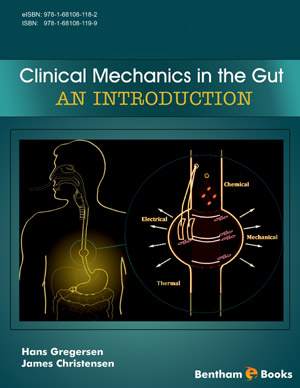Preface
Page: iii-v (3)
Author: Hans Gregersen and James Christensen
DOI: 10.2174/9781681081182116010002
The Geometry of the System: The Structure of the Gastrointestinal Tract as a Mechanical Device
Page: 3-32 (30)
Author: Hans Gregersen and James Christensen
DOI: 10.2174/9781681081182116010003
PDF Price: $15
Abstract
The gastrointestinal tract constitutes an uninterrupted channel through the organism with separate ports for intake and output. This chapter deals first with the basic structure of the wall of the alimentary conduit and with the modifications encountered in each of the various organs, with emphasis on basis anatomy and morphology of the system for a better understanding of the mechanical (motility, distensibility and flow) function and mechanosensory function.
Biomechanical Theory
Page: 33-78 (46)
Author: Hans Gregersen and James Christensen
DOI: 10.2174/9781681081182116010004
PDF Price: $15
Abstract
This chapter aims to give the reader a basic understanding of mechanical theory, especially related to stresses and strains and how these parameters should be interpreted in comparison with more commonly used distensibility measures. The bioengineering way of thinking is introduced and references are made to functional aspects of the gastrointestinal tract. In order to understand the biomechanical complexity it is important to know about the complex anatomical features of the gastrointestinal tract as outlined in chapter 1 of this book.
Methods in the Study of Gastrointestinal Mechanics
Page: 79-112 (34)
Author: Hans Gregersen and James Christensen
DOI: 10.2174/9781681081182116010005
PDF Price: $15
Abstract
Improved understanding of gastrointestinal function depends on improved study methods, for one can consider only those phenomena one can see the evidence for. New multidisciplinary efforts that include the use of bioengineering principles can overcome the problems imposed by the inaccessibility of the gut and by its complexity. This chapter outlines several bioengineering models, methods and analyses from studies of gastrointestinal mechanics. The three main themes are conventional techniques for recording gastrointestinal motor operations, methods involving the stimulation of the gut by distending it, and imaging technologies.
The Mechanical System: Muscle and Connective Tissue
Page: 113-172 (60)
Author: Hans Gregersen and James Christensen
DOI: 10.2174/9781681081182116010006
PDF Price: $15
Abstract
A number of factors affect neuromuscular function in the gastrointestinal tract and so act upon the transport of material. The intrinsic properties of the muscle account for the mechanics. These properties of the muscle itself establish the relationships between length, tension and velocity. This chapter deals primarily with the tissue properties, both active and passive, of the gastrointestinal wall. It seems obvious that the passive properties are related to non-contractile elements where the active properties are due to the contraction of the smooth muscle cells. Hill’s three-element model explains the active and passive elements in the wall and their interaction.
The Mechanical System: Motor Patterns in Organs
Page: 173-214 (42)
Author: Hans Gregersen and James Christensen
DOI: 10.2174/9781681081182116010007
PDF Price: $15
Abstract
The mechanical systems of the gut must move nutrients in whatever complex ways may be necessary in each situation for digestive and absorptive processes to be complete. The mechanical processes vary from one species to another but they differ mainly in quantitative rather than qualitative terms. This chapter deals with the movements of the gastrointestinal musculature throughout the tract. Most of these patterns of motion are inferred rather that observed directly, for the available methods rarely permit the direct and detailed observation of the muscular behavior in vivo.
Disordered Mechanical Function in the Gastrointestinal Tract
Page: 215-235 (21)
Author: Hans Gregersen and James Christensen
DOI: 10.2174/9781681081182116010008
PDF Price: $15
Abstract
This chapter evaluates disorders of regulatory mechanisms such as achalasia and Hirschsprung Disease and disorders of effector mechanisms such as reflux disease, systemic sclerosis of the GI tract and Colonic Diverticular Disease. Definitions, pathogenesis, course, treatment and complications are revealed as well as the bioengineering thoughts of the authors are elucidated.
Future Perspectives
Page: 237-241 (5)
Author: Hans Gregersen and James Christensen
DOI: 10.2174/9781681081182116010009
PDF Price: $15
Abstract
To many physicians, gastrointestinal mechanics often seems a matter of pipes and valves. To gastrointestinal physiologists, gastrointestinal mechanics seems hugely complicated and still, to a large degree, incomprehensible. Most engineers probably have thought so little about the matter to have any opinion about it at all.
Subject Index
Page: 243-247 (5)
Author: Hans Gregersen and James Christensen
DOI: 10.2174/9781681081182116010010
Introduction
The gastrointestinal tract is a series of organs each with distinct mechanical functions. Each organ within the system brings food contents in the gut lumen to the site of absorption through separate mechanical functions. These mechanical functions are generated by a fine-tuned interaction between neuronal networks and active muscle layers. The passive components of the gastrointestinal wall such as the collagen-rich submucosa also play an important role in these mechanical actions. Clinical Mechanics in The Gut provides a thorough understanding of the anatomy and biomechanics of the physiological function and pathophysiology of the gastrointestinal tract. The book first gives an introduction to readers about the physical geometry of the gastrointestinal tract followed by a detailed explanation of biomechanical theory and its application to approximating and modeling gut mechanics. This is expanded further by detailed explanations of gut muscle and motor nerve functions in proceeding chapters. A biomechanical evaluation of disorders of regulatory mechanisms such as achalasia and Hirschsprung disease and disorders of effector mechanisms such as reflux disease, systemic sclerosis of the gastrointestinal tract and colonic diverticular disease are also included. Readers will, therefore, gain an understanding about clinical problems in gastroenterology from a bioengineering and modeling perspective. Clinical Mechanics in The Gut is a useful reference for gastroenterology researchers, biomedical engineers and systems biologists seeking to understand the physiology of the gut and applying this knowledge to surgical procedures, computer-based modeling systems and robotics.






















